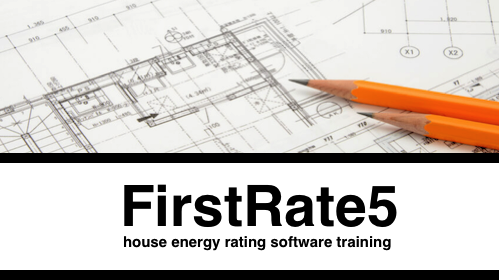This is one of the most common questions asked by new NatHERS Assessors when they start out. Existing Assessors are usually curious as to whether their current software is the most efficient and what alternatives are available. Both groups want to know what the difference is between them and what the pros and cons of each are. In this article I will try to answer these questions to give you an idea of what each software package has to offer.
There are three software packages available for NatHERS assessors to use: AccuRate, BERSPro and FirstRate5. Each of these three have various benefits and weaknesses and also a range of different functions and user interfaces.
All of the three software packages use the same calculation engine so they can produce consistent results. This ‘engine’ is known as the Chenath engine and referred to as the ‘back-end’. The front-end is the software used to enter the data and is the part that give each software its unique data entry qualities and name. No matter which software is used to enter data, the same calculations take place in the background. Prior to release of a full or new version, each software must undergo a stringent accreditation process to ensure consistent results. This is established by completing numerous ratings that compare any prospective software with a set of benchmark results created and verified in AccuRate. The tests are conducted across a number of set designs and across all climate zones. This is a time consuming and detailed process. The requirements are outlined in the NatHERS Software Protocol and all software used to demonstrate compliance with NatHERS requirements must be evaluated against the complex algorithms and other requirements of this Protocol. Theoretically, anyone can apply for access to the Chenath engine and develop their own NatHERS software.
In very simple terms, AccuRate Is a data based software using a spreadsheet style system to enter data, BERSPro is a graphically based software using drawings and graphical icons to collect data and FirstRate5 is, in essence, a combination of both AccuRate and BERSPro.
Let’s look at each of these software packages in turn.
AccuRate
AccuRate was the first software to be developed and was created, and remains supported by, the CSIRO. It is considered the most accurate of all three software packages and is often preferred for research and is always the first software to incorporate any new version if the Chenath engine. As stated above, it is spreadsheet entry based interface that involves taking measurements and data from the drawings and manually entering it into the tables in the software. Assessors need to be able to think clearly in three dimensions, have a sound understanding of mathematics and understand how buildings go together. It can be used for any type of design but is particularly useful for assessing complex buildings as it offers the most access to the complexities of Chenath and allows computerised description of scenarios that are beyond the capability of the other software.
AccuRate contains both standard construction type libraries and allows the creation of custom walls, floors, roofs and ceilings. It has a subfloor and roof-space (attic)zone to allow more accurate data entry. The tab and spreadsheet style layout of the software allows for verification of data, grouping of elements, multi element selection and global updates.
One of the biggest drawbacks of AccuRate is that there is no image of your project, within the software, to help guide data entry. For example, you may accidentally leave out a whole wall and the software has no way of determining that you have made this error. On the upside, detectable errors like a window bigger than a wall is flagged and the errors are usually clearly identified by the software.
In my opinion, all Assessors would benefit from some training in AccuRate as it provides trainees with a greater appreciation of the capabilities of the Chenath engine and assists with understanding the ‘why’ behind some of the processes and assumptions used in BERSPro and FirstRate5.
BERSPro
BERSPro is an easy to use and fairly intuitive NatHERS software. In complete contrast to AccuRate, it uses a graphical data entry and icon system to gather the information needed by the Chenath engine. The data entry area, or drawing canvas, resembles that of architectural programs, such as AutoCad, and graphical software like PhotoShop. People who are familiar with these type software will likely find the data entry process comfortable and familiar. Users import a copy of the floor plan, trace in the zones, set up standard or default construction types and then use various buttons to add additional information, to provide the detail needed. The software automatically assigns walls adjacent to each other as ‘internal and adds wing walls to immediately adjacent zones . Sub-floor and roof space zones are automatically created using some basic data including on ground or elevated for floors and hip or skillion for roofs. All data can be checked and verified in reports accessible from within the software and then refined by selecting the relative elements.
When BERS was originally created, it was based around the theory that small differences will occur from job to job, assessor to assessor and that these differences would have very little impact on the overall outcome of the rating and subsequent regulatory inclusions. It was almost a ‘near enough is good enough approach’. This is contrary to the way the industry is being led today but has proved to be a valid approach particularly for rating spec-built homes designed by volume builders. Multiple re-accreditation processes have shown that results are within 2.5% of the benchmark results across hundreds of rating scenarios. With this in mind, the zones drawn into BERSPro are drawn as touching each other with the internal walls drawn into the software down the middle of the internal wall. This approach does vary the floor areas slightly, but this is corrected within the software and reported on the NatHERS certificate as though drawn to each internal face, as in the other packages. If you are worried about requirements of the technical note with regards to using internal areas. Don’t. The BERS software just works, and much of the information in the Technical notes has been written with a focus on the other two software, mostly due to the key areas of expertise of the writers.
Despite using the Chenath engine, users of BERSPro have to interpret a few items slightly differently to users of the other software packages. The first of these is the way windows are added and their properties set. In BERS, windows are considered individual elements and not an inherent part of the wall as in AccuRate and FirstRate5. The other difference is that obstructions are entered relative to the drawing canvas, like in a CAD package, rather than relative to the building itself. This may sound confusing but will be explained in any training you undertake and, once mastered, will feel quite natural.
BERS does not include a custom element builder like Accurate and FirstRate5, but does include some unique useful tools for calculating the R-values & U-values of materials and air-gaps that can then be used to adapt the standard material selections to mimic the actual performance of the custom constructions. These calculators can also prove useful in Section J and DTS calculations.
There are some parts of BERSPro that are not as intuitive as they could be. This is mostly because the software has continued to grow from its early versions and the current developers are left with these legacy restrictions. Despite its graphical nature, the software does not show all of the data it could on the drawing canvas. Unfortunately, adjacent obstructions such as fences and neighbours, wing walls and stair voids are not shown graphically. This can be frustrating, especially in the review phase. In addition, obstructions always start from the lower floor and no base height or permeability can be entered. This can cause an issue for upper level balcony and lattice or similar, screens. It is not an issue in units, for which BERS is well suited, as each unit is a dwelling with a new ground level.
FirstRate 5
FirstRate5 is easy to use and intuitive. It combines the best functions of AccuRate and BERSPro, using a combination of table style data entry and a graphical interface. This allows flexibility when entering data and gives the user greater control as well as the ability to verify and correct information. The plan is imported and traced, as in BERSPro, but the information can be viewed beside the drawing by selecting individual elements (walls, floors, areas, zones). The table portion allows multiple element selection providing an efficient way of grouping and changing elements, just like AccuRate.
The zones are traced ‘as drawn’ which means that the internal walls are followed. When the software detects a nearby zone it will (usually) assign as having an internal construction. Drawing either side of the internal wall produces areas consistent with AccuRate without any software calculation needed. The software includes simple ‘shift’ function to draw in orthographic mode. (BERS has an ‘ortho mode’ but it is not as easy to use and is a little more unstable). As with BERS, FirstRate automatically detects wing walls and creates subfloor and Attic (roofspace) zones.
The software contains numerous inbuilt wall and floor constructions and also contains a wall and floor builder. In contrast to AccuRate, FirstRate5 gives a graphical representation of the created element which can be extremely useful in ensuring you have included all of the necessary layers. It does not allow the creation of roof and ceiling construction systems and the data entry panel used to collect this information remains a little clunky, in my opinion, and contains some unnecessary, and therefore confusing, fields. Whilst the custom wall and floor builder tools create accurate descriptions of the element, including the individual layer and total R-values, the roof/ceiling tool is relatively simplistic. In addition, FirstRate 5 cannot model slab edge insulation (Editors Note: Slab edge insulation modelling feature was introduced in the FR5 update released on 1 May 2020).
Users can enter both horizontal and vertical shading and obstructions by drawing them on and then refining the entry using the data entry tables as needed. These are then shown on the drawing canvas (Plan tab) making it easy to verify their entry. Consistency in width, height and other parameters can be checked and changed in the tables. Users are also able to draw on stair voids.
One key thing to remember when using graphical software is that the software cannot ‘see’ and interpret what you are drawing. It can only use what you have drawn to fill in data in the calculation engine. This is a very difficult concept to get your head around and why I believe it is important that Assessors have some understanding of AccuRate, and the fields that the engine requires for calculation.
How much do they cost?
The three NatHERS software work on different financing models.
FirstRate is free to download from www.fr5.com.au but all certificates incur a charge. This fee applies even if you are simply making a correction that you came across once certified. FirstRate has its own data portal to generate NatHERS Certificates. As the software is free, and comes with a detailed handbook, you can register and play around with the software as much as you like providing you do not generate a certificate. If you choose to train in FirstRate you need to be really vigilant in checking the generated draft reports prior to certification.
AccuRate and BERSPro are available from www.energyinspection.com.au and use the HERS Portal developed by the CSIRO. You must buy the software but the price includes a number of certificates that cancels out the cost of those certificates, so is free in a round about way. Certificates are also charged but it is only paid once, including when changes are made. A Demo version of AccuRate is available for free download. It is fully functional but locked to a single postcode. Training licences are available for enrolled trainees of BERSPro that usually expire after a month. Full details can be found by contacting Energy Inspection.
So which one should I use?
This article has given some basic information on the software packages available to NatHERS Assessors. Ultimately, the choice often comes down to personal preference and research before you conduct training. I highly recommend having experience in multiple software packages as this gives you greater flexibility as a NatHERS Assessor.







